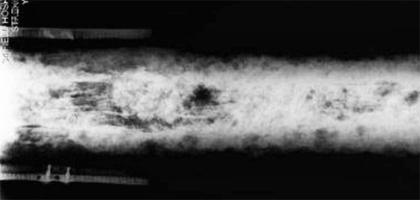Ben Miller
Source - http://www.culture24.org.uk/history-and-heritage/archaeology/art507339-army-hospital-x-rays-reveal-intricacies-of-anglo-saxon-sword-shield-spear-and-grave-goods
Sixth century grave goods found at Anglo-Saxon burial site scanned by army as archaeologists examine x-rays

Archaeologists have enlisted the help of the army to x-ray a sword found in Salisbury during the summer© Wessex Archaeology
Archaeologists have used an army field hospital’s x-ray machine to examine a corroded steel sword, confirming the pattern of the weapon alongside a spearhead and shield core found at a burial site on Salisbury Plain.
The 85 centimetre blade was found with the grave goods at Barrow Clump, a 40-metre cemetery where 27 bodies – including the remains of Anglo-Saxon warriors – were discovered in 2012.
“The sword was too large for our in-house x-ray facilities,” reflects Laura Joyner, of Wessex Archaeology, who says the sword caused “great excitement” at the excavation.
“We were keen to learn as much as possible about this 6th century weapon, although the degree of corrosion on the sword and the fact that it was contained within the remains of its wood and leather scabbard meant that we would need to use an x-ray machine to do so.

The level of corrosion means experts will be unable to remove the scabbard from the blade© Wessex Archaeology
“The Army, through Captain Doe and Sergeant Potts, kindly offered to undertake the work using equipment based at a Field Hospital Unit in Aldershot.
“The x-ray images confirmed several things that we suspected about the sword, and revealed some interesting features.
“The sword was made by a process called pattern welding, where several bands of metal are beaten together to create a single strengthened blade.
“In this case, three twisted rods of wrought iron with steel surfaces were used, showing as a distinctive pattern on the x-ray image.
“The blade itself was also edged in steel. This is probably because steel can be sharpened to a much finer edge than iron. It is possible to tell the difference between metals on an x-ray image as they corrode in different ways.”
Broaches, amber and glass beads, spear heads, a silver ring and drinking vessels have previously been found at Barrow Clump
Experts were equally thrilled at the chance to scan the other grave goods.
The sword was accompanied by a shield boss - the metal centre of a wooden shield
“The spearhead is not pattern welded like the sword, but was produced from a single piece of iron,” says Joyner.
“The shield boss has retained its studs to fix it to the wooden shield, which are plated with tin to make them into a decorative feature.”
Conservators will now analyse mineralised wood, leather and organic materials from the scabbard.